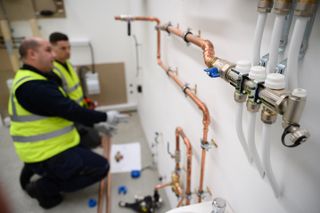Why does my water pressure keep dropping after retrofitting a heat pump?
If you've replaced your boiler with an air source heat pump, you may have noticed a drop in water pressure when running hot taps and showers. Heat pump expert David Hilton explains why — and the simple fix to this problem

If you've found that your water pressure has dropped after installing an air source heat pump into your existing home — there's a simple solution.
But first, let us explore the cause and why this problem tends to happen after retrofitting anair source heat pumpand not so often when installing one in a newly-built property or home that has been completely re-plumbed.
It's also helpful to understand that plumbing in many British homes was originally designed around water tanks being in the loft due to unreliable pressure and flow from the mains water supply. These were referred to as vented systems. By lifting the water up to the loft the height gave it a gravity-fed pressure. The higher it was, the better the pressure. It also allowed for expansion of the central heating water as it heated up.
Mains water supply has now been significantly improved in most areas and as such we no longer need the gravity systems as we can get much better water pressure directly from the incoming main.
Why does my water pressure keep dropping after installing a heat pump?
With high pressure and high temperatures from gas (or oil) boilers we needed to mix a lot of cold water into the hot water in order to not scald. Thehot water storagemay have previously been at around 70°C. Meanwhile, with a heat pump cylinder, you may typically store water at around 50°C.
Considering that the water temperature that you shower at is around 38°C, you will need to blend a lot more water to the high temperature water than the lower temperature water with the heat pump cylinder to bring it down to 38C.
This can sometimes cause a few complications when changing from a high temperature boiler to a lower temperature heat source such as wheninstalling an air source heat pump.
Issues usually happen in areas where you have a very good pressure coming into the home from the main supply. The plumbing may have been modified in your home over the years and if mixing valves (thermostatic showers) have been added then you may notice a drop in temperature with the new low heat source.
The problem is usually caused by the hot water cylinder having a pressure reducing valve and the cold water supply coming directly from the main cold feed. This means that the cold water could be at a higher pressure and overpower the hot.
What can I do to fix my water pressure?
This problem can be solved by fitting another pressure reducing valve on the cold feed to balance the hot and cold water pressure.
在新的构建这通常是照顾家by plumbing the hot and cold from the same pressure reducing set on the cylinder. However, it might have been overlooked when retrofitting an air source heat pump into an existing home.
In areas with lower pressure main water supply, the imbalance of pressure due to pressure reducing valves is not really a problem. That said, there may also be unbalanced pressure in the taps if the hot water pipe runs are smaller-sized pipes or they have much longer runs and many more elbow fittings.
It is important to be sure that the water is balanced and, if in doubt, it is worth getting a good plumber in to check the system flow and pressure to be sure your system is optimised. It's probably worth making sure that you understandhow do heat pumps workyourself too, if you don't already.

Get the Homebuilding & Renovating Newsletter
Bring your dream home to life with expert advice, how-to guides and design inspiration, direct to your inbox.
David is a renewables and ventilation installer, with over 35 years experience, and is a long-standing contributor to Homebuilding and Renovating magazine. He is a member of the Gas Safe Register, has a Masters degree in Sustainable Architecture, and is an authority in sustainable building and energy efficiency, with extensive knowledge in building fabrics, heat recovery ventilation, renewables, and also conventional heating systems. He is also a speaker at the Homebuilding & Renovating Show.
Passionate about healthy, efficient homes, he is director of Heat and Energy Ltd. He works with architects, builders, self builders and renovators, and designs and project manages the installation of ventilation and heating systems to achieve the most energy efficient and cost effective outcome for every home.
Bring your dream home to life with expert advice, how-to guides and design inspiration, direct to your inbox.
Thank you for signing up to Homebuilding. You will receive a verification email shortly.
There was a problem. Please refresh the page and try again.

